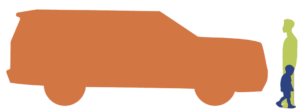
Bigger, heavier, higher … large SUVs and pickups pose serious safety threats to vulnerable road users
This page was last reviewed on August 26, 2024
By Isabelle Joncas, B.A., Équiterre
Abstract
In Canada, the recent rise in the number of small trucks on our roads is phenomenal (a category that includes sport utility vehicles such as SUVs, pickups, mini-vans and crossovers). They are sold as practical, functional, safe and adventurous. With fewer compact models being offered in car dealerships, many buyers find themselves with a vehicle bigger than what they need. This trend comes with a set of impacts ranging from greater danger, greater greenhouse gas emissions and greater expense. Large SUVs and pickups are defined with a higher front end than cars that poses, in the event of a collision, a greater risk to vulnerable road users, according to recent research.
How can we tackle the issue? Providing information to citizens is a key to raise awareness so people choose a car that fits their real needs. Équiterre has been campaigning in Québec for the last three years on this topic. Policy is the second key action to bring about change and send a signal to both car manufacturers and citizens; policy changes could include introducing a tax based on weight and size of vehicles; a tax on services (e.g., parking); and new regulation of large polluting vehicle publicity. There are many options and these must be effectively and quickly pushed forward.
Introduction
Small trucks (SUV, crossovers, pick-ups, vans) not only cause more pollution and burn more fuel – on average 20 per cent more than a car – but they also pose a greater risk to pedestrians and cyclists. If ranked among countries, the global (worldwide) fleet of SUVs would be the world’s fifth largest emitter of CO2, according to the International Energy Agency reporting in May 2024 (1). In Canada, sales of SUVs are on the rise. They reached 85 per cent (2) of the total vehicle sales at the end of 2023.
Figure 1 : Share of passenger vehicle sales in Canada. Available from : https://www.cbc.ca/news/science/suv-survey-quebec-1.6792349
Recent international research findings
- Research done in 2004 in the United States shows striking figures: A pedestrian has a 13-per-cent probability of getting killed in a collision involving a passenger truck compared to a five-per-cent probability if hit by a car (3). This means that pedestrians are 2.5 times more likely to die if they are hit by a passenger truck than by a car
- Recent research shows a strong relationship between large vehicle collisions and vulnerable road users: in 2022, the Journal of Safety Research found that children are eight times more likely to be killed when hit by an SUV or light truck than those struck by passenger cars (4).
- In 2023, the Insurance Institute for Highway Safety (IIHS) states that “whatever their nose shape, pickups, SUVs and vans with a hood height greater than 40 inches (102 cm) are about 45 per cent more likely to cause fatalities in pedestrian crashes than cars and other vehicles with a hood height of 30 inches (76 cm) or less and a sloping profile (5)”.
- An earlier (2022) IIHS study found that large cars also make it harder to see pedestrians at intersections, resulting in not only deadlier, but more frequent collisions: in North Carolina, at or near intersections, pickups were 42 per cent more likely and SUVs were 23 per cent more likely than cars to hit pedestrians when turning left (6).
- In the event of a car-SUV collision, fatalities are 28 per cent higher for the car drivers and passengers when SUVs are involved (7).
- Research has shown that while SUVs struck 14.7 per cent of the pedestrian and cyclist collisions studied, they were involved in 25.4 per cent of all fatalities to pedestrians and cyclists (4).
- In March 2024, Justin Tyndall, University of Hawaii, published data showing that a mere 10 cm increase in front-end height causes a 22-per-cent increase in pedestrian fatality risk (8). In a previous study, Professor Tyndall estimated that between 2000 and 2019, more than 8,100 lives were lost in crashes in the U.S. with pickups and SUVs that would otherwise have been spared had the crashes involved passenger cars (9). The fact that these numbers, according to Professor Tyndall, are increasing on a year-over-year basis is of particular concern, underpinning the urgency for action. Vias published in “The Belgium” in August 2023 stated that a cyclist or pedestrian being hit by a front-end vehicle with a hood height of 90 cm has a 30-per-cent higher chance of death compared to being hit by a 80 cm front-end vehicle (10).
Specifically for cyclists, the Insurance Institute for Highway Safety (IIHS) reported in 2023 that ground-impact injuries – a frequent cause of head injuries – were more than twice (11) as common in SUV crashes than those involving cars. Forbes reports that research consistently shows that such larger vehicles are more likely to knock bicyclists to the ground, where they can be run over by the vehicle, thus causing more serious injuries, compared to vaulting them onto the hood of the vehicle. On average, the overall trauma to the body is 55 per cent higher and head injuries 63 per cent higher in SUV crashes (12) than in car crashes.
One can infer from the rise of SUVs and passenger trucks, and the resulting increased risk of serious injury and death, that this trend will ultimately affect the quality of life in our neighbourhoods and communities by posing safety risks to everyone, but especially to the most vulnerable, such as children, the elderly and people with reduced mobility.
Équiterre research findings
Équiterre conducted research in 2020 on the impacts of the rise of small trucks in Canada, their classification, the evolution of the fleet over the years, the impact of publicity on the choice of the consumers and their motivations behind their decision regarding the purchase of a vehicle. One key element in this research is that people who own a SUV have little concern about the danger that their vehicle may pose to others.
Équiterre’s ongoing actions
With that in mind, Équiterre mobilized groups in Québec and launched a public awareness campaign in 2021. Advertised on television, radio and on the web, it shared information about the impacts of the rise of small trucks that were addressed from three angles: threats to our safety, our environment and our wallets: larger vehicles cost on average $10,000 more.
How can we tackle the issue? At the policy level, recognizing the impacts of SUVs can translate to regulation and we can turn to Europe for inspiration in developing measures. For instance, France imposes a sales tax on vehicles heavier than 1,600 kg (13) and that emit more than 110 grams of CO2 /km, reaching 60,000 Euros if a vehicle exceeds 193 grams of CO2 / km.
In Europe and in Canada, some cities or neighbourhoods have raised parking fees for bigger vehicles (for example, in Montreal) showing some that municipal governments are aware of issues created by larger vehicles.
Some cities in Europe advocate for annual registration fees to increase while in Canada a group of citizens are petitioning the federal government to regulate vehicle size and safety regulations. Équiterre advocates that Canada create advertising regulations on gas and high consumption vehicles. This petition is still open and if your organization wants to share and advocate along this goal, feel free to share.
Bio: Isabelle Joncas, B.A.
Isabelle has a bachelor’s degree in agriculture from McGill. She has co-ordinated the network of family farmers at Equiterre for 17 years, contributing to synergy amongst farmers, collective tools and resources, and she has led promotional campaigns for citizens to sign up for yearly subscriptions to organic baskets. She joined the Sustainable Mobility team in 2018 to be in charge of the Running Electric campaign. Since 2021, Isabelle has been responsible for the For Human Size Transportation Campaign.

References
- Cozzy L. Petropoulos, A. SUVs are setting new sales records each year – and so are their emissions [Internet]. International Energy Agency. 2024-05-28. Available from : https://www.iea.org/commentaries/suvs-are-setting-new-sales-records-each-year-and-so-are-their-emissions
- Statistics Canada. New Motor Vehicle Sales [Internet]. 2024-07-15. Available from : https://www150.statcan.gc.ca/t1/tbl1/en/cv.action?pid=2010000101
- Morency C., Milord B., Bourdeau J.-S., Verreault H., Khan. N.A., LES CAMIONS LÉGERS Impacts de la transformation du parc de véhicules légers au Québec. [Internet], Polytechnique Montréal. February 2022. Available from : https://cms.equiterre.org/uploads/Rapport3_ChaireMobilite.pdf
- Edwards M., Leonard D. Effects of large vehicles on pedestrian and pedalcyclist injury severity.[Internet]. Science direct. 2022-09. Available from : https://www.sciencedirect.com/science/article/abs/pii/S002243752200081
- Vehicles with higher, more vertical front ends pose greater risk to pedestrians [Internet]. IIHS. 2023-11-14. Available from : https://www.iihs.org/news/detail/vehicles-with-higher-more-vertical-front-ends-pose-greater-risk-to-pedestrians
- SUVs, other large vehicles often hit pedestrians while turning. [Internet]. IIHS. 2023-05-22. Available from : https://www.iihs.org/news/detail/suvs-other-large-vehicles-often-hit-pedestrians-while-turning
- Brazeau A, Denoncourt J-C, Lefrançois N, et al. Comprendre la hausse des camions légers au canada afin de renverser la tendance-synthèse. [Internet]. 2022. Available from : https://cms.equiterre.org/uploads/rapport_synthese-fr_19oct.pdf
- Tyndall J. The effect of front-end vehicle height on pedestrian death risk. Science direct. 2024-03. Volume 37.
- Tyndall J. Pedestrian Deaths and Large Vehicles. Economics of Transportation, 2021. Vol. 26-27.
- Des voitures plus lourdes, plus hautes et plus puissantes pour une sécurité routière à deux vitesses ? [Internet]. Vias. 2023-08-30. Available from : https://www.vias.be/fr/newsroom/des-voitures-plus-lourdes-plus-hautes-et-plus-puissantes-pour-une-securite-routiere-a-deux-vitesses-/
- Higher point of impact makes SUV crashes more dangerous for cyclists.. [Internet]. IIHS. 2023-04-13. Available from : https://www.iihs.org/news/detail/higher-point-of-impact-makes-suv-crashes-more-dangerous-for-cyclists
- Mohn, T. For Cyclists, SUV Crashes Are More Deadly Than Car Crashes. Forbes. 2023-04-14. Available from : https://www.forbes.com/sites/tanyamohn/2023/04/13/for-cyclists-suv-crashes-are-more-deadly-than-car-crashes/?sh=3fb454591ea4
- Malus au poids : les règles actuelles. Eplaque. 2024-03-07. Available from : https://www.eplaque.fr/fiscalite-automobile/malus-au-poids